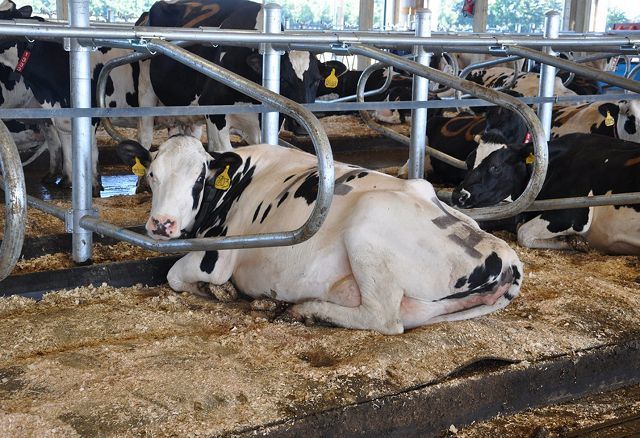The comfort of waterbeds down on the farm
Bessies got a waterbed!
Bessie, however, is a bovine, or cow; a dairy cow, in fact.
The whole idea (of the cow waterbeds) is for cow comfort, to do the best thing for the cows, to make them comfortable and happy, explained Connie Finton, whose Tuscarawas County farm family operates Carlene Farms outside New Philadelphia. We have had them a couple of years now, and they are becoming the in thing. People are coming to realize that these are the best things for cows.
The idea of waterbeds for cows is research based. Studies done by Dr. Wendy Fulrider, who did her research under the supervision of renowned animal behaviorist and researcher Dr. Temple Grandin, were initially published in 2007, and showed that use of the water filled beds resulted in a reduction in lesions and lameness, and overall increased positive outcomes in herd health, herd costs, and producer satisfaction. Regardless of which outcome is focused on, Bessie wins hands (or hocks) down each and every time.
Finton credits the forward thinking of her husband, Cliff, for putting the cow waterbeds into place on their farm.
Cliff started because he is pretty up front, and likes to try new things to keep the cows as comfortable as possible. Our job is to take care of them. We believe that it helps our cows produce and give more milk, she said, noting that the situation is similar to the results in any positive work environment, whether it be with humans or bovines. When any employee is happy in the job place, they do better work.
Chris Zoller, Ohio State University Agricultural Extension agent, is convinced that the cow waterbed systems are a good thing, although he admits that many dairy farmers have not been as quick to embrace the concept as have Carlene Farms.
Obviously, its from the perspective of the cow, stated Zoller. Anytime you can make her environment more comfortable, she is more content, and that helps to contribute to higher milk production. Use of the water beds can potentially affect somatic cell count because of the cleaner environment because it minimizes contact with manure and mud. Typically, this is for milking cows housed in a barn. Think of your own bed. A motel bed or a strange bed elsewhere just wont be as comfortable as your own. Zoller also pointed out that cows are creatures of the order. The best thing you can do for a cow is make her life very routine. She likes order. The use of cow waterbeds fit into that need for a comfortable routine.
Cow waterbeds are 7-by-4 rubber mattresses with two water filled chambers that hold about 14 gallons of water. Units cost about $300.
Advocates cite studies and anecdotal evidence showing that the waterbeds flex and flow with the animals skin and reduce pressure points, dry quickly and thus inhibit bacterial growth, dont pack down like traditional bedding and thus remain more comfortable for the cow, promote more rest and decrease lameness, and stay cool in summer and warm in winter.
Dean Throndsen, of Reedsburg, Wisc., invented the dual chamber cow waterbed, which he introduced to the American market in 2003, after seeing the application of single chamber cow waterbeds which were manufactured by a European company. Throndsens daughter, Amy, explained that the family is convinced that the units make a difference.
Currently, we have the waterbeds installed in 19 countries, with a total of 250,000 individual stall waterbeds installed worldwide, she stated. Cow comfort and animal health are our top priorities.
When we first started doing our study, we thought it was a joke, said Grandin in a recent interview. Grandins balanced work on providing optimum care for animals, particularly those involved in human food production, is legendary, as are her innovative approaches to animal agriculture. Then we saw the data. They work. If I built a dairy farm today, Id put them in.

